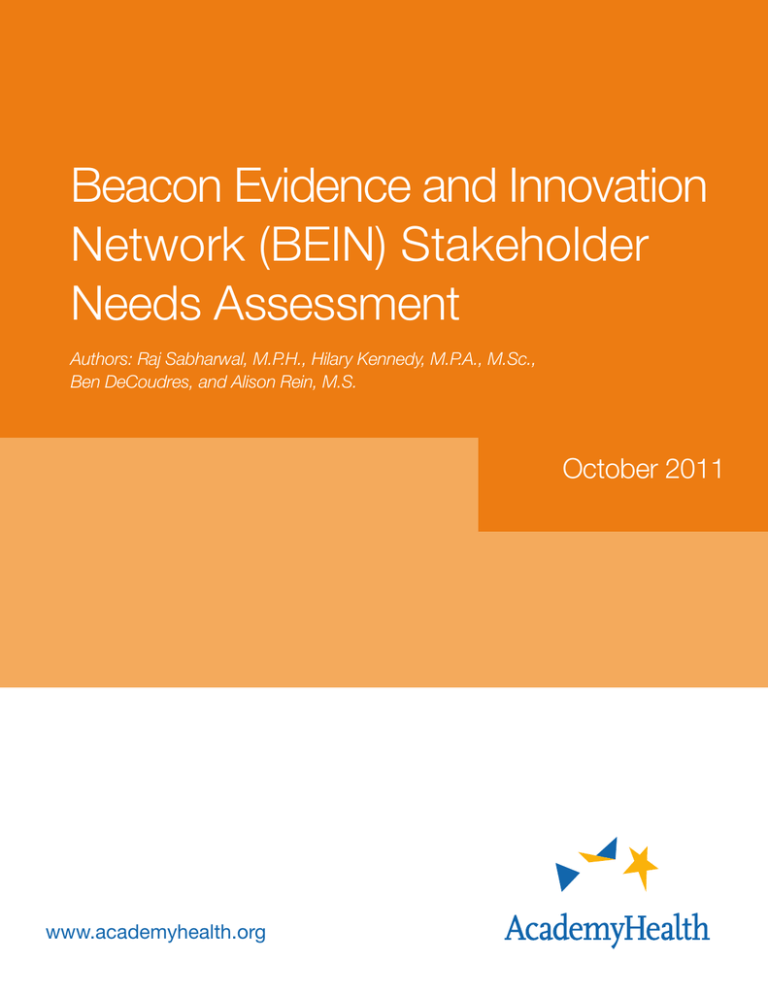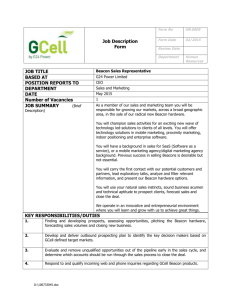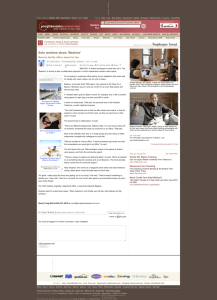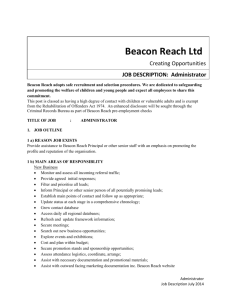Beacon Evidence and Innovation Network (BEIN) Stakeholder Needs Assessment October 2011
advertisement

Beacon Evidence and Innovation Network (BEIN) Stakeholder Needs Assessment Authors: Raj Sabharwal, M.P.H., Hilary Kennedy, M.P.A., M.Sc., Ben DeCoudres, and Alison Rein, M.S. October 2011 www.academyhealth.org 1 Introduction The 17 Beacon Communities are focusing on specific and measureable improvement goals in three areas that are central to delivery system reform and improvement — quality, efficiency, and population health — to demonstrate the ability of health IT to transform local health care systems. Each community has developed interventions that reflect its own priorities within this broad set of objectives. For example, some communities are focusing their chronic care efforts on diabetic patients, while others are prioritizing patients with asthma or other chronic conditions. Their efforts are intended to illustrate how improvements in patient care and cost savings can be achieved through the electronic collection, sharing, and analysis of key clinical data. The evidence generated through the Beacon Community Program (hereafter referred to as the Beacon Program) will be among the most substantive and timely information on the impact of health IT strategies on health care and outcomes that emerge from American Recovery and Reinvestment Act (ARRA) funding. This information is highly anticipated by community, state, and national decision makers who are being encouraged to adopt health IT as a means of improving both individual and population health, while decreasing (or at least holding steady) costs. Given the unprecedented investments, the communities will be tested not only according to their ability to perform, but also in their ability to generate momentum and sustain progress. Success across all areas will certainly be tied to meaningful stakeholder engagement. To ensure that the information needs and values of key community leaders are better understood by the Beacon Communities, AcademyHealth, with support from The Commonwealth Fund and in collaboration with the Office of the National Coordinator for Health Information Technology (ONC), conducted a series of telephone interviews with select national and community stakeholders. The national stakeholders included federal officials, senior congressional staff, and leaders from organizations focused on the use of health IT to improve health care. For local stakeholders, we targeted individuals from both the public and private sector with indirect connections to the Beacon Community, including business leaders, politicians, and thought leaders in the community. This report reflects our findings from the stakeholder interviews1 and is intended to assist the Beacon and other communities as they think about how to best engage and inform their constituents, promote their successes, and provide honest assessments as to why certain aspects of their initiatives are not working as well as expected. Our intent is to provide this feedback at the front-end of the program to ensure that the findings coming out of the Beacon Program are of highest value and relevance. The lessons generated by both individual Beacon Communities and the program as a whole will be used to inform longterm sustainability for community level efforts, and also will aid the spread of these activities to other communities. In addition to measuring outcomes, there will be great value in understanding the journey —including the issues and obstacles faced by Beacon Communities along the way and the workaround solutions required to progress past these challenges. In addition to discussing their familiarity with the Beacon Program and its activities, stakeholders provided insights on the level and type of information they hope to see emerge from the Beacons, and how this information should best be disseminated. Interestingly, while some minor differences in opinion were apparent between national and local stakeholders (as noted in text that follows), these differences were typically based on a particular context or personal experience. Overall, both local and national stakeholders were in agreement on general themes regarding priorities, and on the types of information they hope will emerge from the Beacon Program. Stakeholder Awareness of the Beacon Program The majority of both national and local stakeholders indicated a basic level of familiarity with the Beacon Program. However, perceptions tended to be based on initial efforts by communities to assemble support for their proposals (local), various journal/news articles, meetings, or presentations from the U.S. Department of Health and Human Services (HHS) or ONC leadership (national). Most national stakeholders— though not tracking specific activities within individual communities — were aware of the program’s purpose, its emphasis on quality, cost, and population health, and its focus on specific disease areas such as diabetes and asthma. Nearly all expressed interest in receiving more information on the activities of the Beacon Program, including updates on the overall project, as well as highlights from the individual communities. Several suggested that a quarterly newsletter or report from ONC would be a convenient and effective mechanism for these updates. National stakeholders also expressed confusion or concern regarding the relationship of the Beacon Program relative to other policy initiatives, such as accountable care organizations and the “meaningful use” criteria for electronic health records (EHRs). Stakeholders noted the importance of publicizing successes and insights as they emerge from the Beacon Program, particularly those of potential relevance to other important initiatives. 3 As expected, local stakeholders were more knowledgeable about the goals and activities in their respective communities. Many had been asked to participate in the early phases of the proposal development process based on their relationship with the coordinating organization(s) and/ or their position in the community as politicians, business leaders, and/or health care thought leaders. Typically, these local stakeholders were not involved in the initial funding proposals for the program beyond confirming the participation and/ or support of their organization. Despite this early familiarity, most local stakeholders indicated a lack of regular engagement with the ongoing program in their communities. By and large, they do not engage with program leadership on a regular basis, nor are they involved or consulted on specific Beacon Program activities. Rather, they view themselves as connectors between the local Beacon effort and existing community health initiatives, as well as other potential partners. A few even described themselves as cheerleaders for their Beacon effort, working to ensure that their business and social contacts were aware of the program’s importance and potential. Finally, while many of the local stakeholders were pleased with the information and updates provided by their local Beacon Community, others expressed frustration with the lack of proactive outreach and reporting on progress thus far. Many suggested that — even absent results or improvements — it is important for them (and they assumed for others) to receive regular updates and feel invested in the efforts. For others, the frustration stemmed from a perceived lack of substantive results or progress thus far—particularly given the amount of time, effort, and resources expended for implementation. 4 Prioritizing Objectives All of the Beacon Communities have established specific objectives designed to improve the quality of care provided to patients, reduce or hold steady health care costs, and/or improve population health. The process for establishing these objectives helped to clarify the initiative’s overall strategy and use of resources, while also highlighting and resolving potential disagreements among its stakeholders.2 Given their varying roles, stakeholder respondents were asked to reflect on the alignment of these domains with the concerns of their constituents and/or community members, and to provide their opinions on the relative importance of each. Not surprisingly, many resisted the request to rank, suggesting that all three are important and inextricably linked. As conversations evolved however, many stakeholders imparted slight preferences for one or two domains over the others. Many stakeholders prioritized cost-related objectives, based primarily on their concerns regarding unsustainable increases in health care expenditures and their impact on access and patient care. As such, objectives focused on cost management or cost reduction activities were perceived as necessary to maximize the use of available resources within their communities. Thinking ahead toward sustainability, these stakeholders also noted that key audiences, including legislators and other policymakers, were primarily interested in cost issues and looking for opportunities to shave budgets. Therefore, objectives or interventions directly addressing costs were noted as providing greater political traction for the program. Similarly, many stakeholders acknowledged that those in the business community are most concerned with efforts to improve employee health status and productivity (e.g., through reduced absenteeism), and how such efforts might help them lower their overall health care costs. Recognizing the strong linkages, cost was viewed as both a driver for achieving gains in population health and quality as well as a potential measure of such gains. Commenting on the relationship between population health and costs, one stakeholder noted that “in order for us to impact cost we need to make a drive toward population-based health outcomes.” Other stakeholders reflected that quality improvement is directly linked to cost-reduction, and that interventions accounting for both quality and cost may provide the greatest gain. “Population health is the goal, quality is the description of it… and healthy people are integral to keeping costs down.” Other stakeholders commented on the connection between quality and population health, noting that real changes in quality improvement would likely result in observable changes in population health. Still, as one stakeholder noted, “While everyone agrees we need to improve quality, they just don’t always agree on how to get there and how best to measure it.” Among those stakeholders with public health training or experience, population health was considered to be a composite of the other areas of focus, and a measure of success for all Beacon Communities (i.e., they should be evaluated on their ability to improve the overall health status of the local population). However, in comparing population health’s importance to the other priority areas, one stakeholder noted that “policymakers and the public often don’t perceive or understand the impact of population health, outside of disasters or other catastrophic events.” General Information Needs With respect to general information needs, respondents indicated that — for many — the success of individual communities will be based primarily on pre-versus-post outcome measures. This reinforces the need for communities to establish some strong baseline estimates, and to clearly articulate their target population(s), prioritize among their objectives, and have tools in place to track their progress. In addition to clinical (e.g., asthma in control) and cost-related (e.g., reduced duplicative testing) outcomes, respondents also noted that it will be important for the Beacon Communities to document whether, and if so how, the processes of care delivery (e.g., patientprovider communications) change as a result of the interventions. Others expressed an interest in seeing cross comparisons of Beacon Communities in order to determine which types of interventions worked, under what circumstances, and to what extent, given the range of characteristics unique to the individual Beacon Communities. Respondents confirmed that such information could be leveraged to figure out how the learnings from one community might be translated for others. Stakeholders also need more information on chronic disease management, with an emphasis on population based metrics, in an effort to help their community improve overall health outcomes. Of particular interest is the Beacons’ potential to improve outcomes for patients with multiple chronic conditions, who are often the largest users of the health system with the poorest results. As one stakeholder noted, “If you can put an infrastructure in place that works for them, you can make that system work for anyone.” Beyond metrics, stakeholders are also interested in learning how the Beacon interventions will address continuity of care, through EHRs or other mechanisms. Other stakeholder areas of interest include interventions that target increasing immunization rates among children, length of hospital stays related to childhood asthma, and changes in body-mass index (BMI) among high-risk population groups. Specific to diabetes, stakeholders noted the tremendous potential of interventions that identify and target at risk “prediabetic” individuals and seek to halt their progression to full-blown diabetes. In addition, stakeholders commented on the importance of learning from diabetes and other condition-specific interventions that target certain population groups, including children and individuals with low socio-economic status, as well as minority groups such as African Americans or tribal communities. Timing of Results As expected, many stakeholders commented on the potential difficulty of demonstrating definitive results given the program’s aggressive timeframe (three years). The general consensus was that communities should take a two-pronged approach: 1) focus on key objectives for which near-term positive trends could reasonably be achieved, and 2) make progress on longer-term outcomes that may begin to appear as the program concludes. It was noted that, ideally, these longer-term outcomes should continue to be measured even after the formal program ends — regardless of the manner in which activities are sustained on a local or state level. Recognizing that many of the Beacon Communities are well shy of having clinical and cost outcomes data available for dissemination, respondents suggested that even initial impact data (e.g., number of newly engaged providers) should be actively communicated. It was posited that these early signs of progress could help to keep both internal and external partners interested and engaged in the program. Still, they cautioned that Beacon Communities will soon need to show their impact and provide hints of improved outcomes to ensure longer-term interest and commitment of resources. Observing that stories are important, stakeholders noted that in the first two years, much of this information could be anecdotal. “Given where states are, from a sustainability point of view, seeing cost reductions efforts is going to have a bigger impact.” Many cautioned that, despite the tight timeframe for the program, a three-year period should be sufficient to generate some positive trends, particularly for outcomes like hospital readmission rates and childhood immunizations. Value of Health IT Many stakeholders noted the opportunity for the Beacon Communities to demonstrate the value of health IT in supporting care delivery and improving outcomes, while also acknowledging the potential for this program to surface previously undocumented or under-documented challenges associated with community-wide heath IT implementations. For example, stakeholders were interested in the Beacon Community experience with respect to care coordination across a health system — including providers, clinics, and hospitals. Stakeholders also viewed this as an opportunity to learn about whether broad health IT deployment enables otherwise fragmented entities in the system to integrate care and operate more 5 effectively. Respondents also expressed interest in identifying the specific features and functions that should be deployed early on in order to generate positive, nearterm results. role that HIEs will play in the collection and reporting of quality measures. Others simply expressed an interest in gleaning lessons and “best practices” that could help inform other HIE efforts. “As a legislator, personal anecdotes and stories are always welcome.” Dissemination Strategies Specific to EHRs, stakeholders noted their interest in quantitative progress markers, such as how many additional offices or clinics adopted and integrated EHRs into their practices, supplemented with testimonials. They also expressed interest in perceived utility and user experiences of EHRs among non-physician clinical staff (e.g., nurses) and patients. “If we don’t see quantitative improvements in chronic care over the length of the Beacon Program that is okay, but we should be able to see some intermediary measures.” Stakeholders also expressed interest in how Beacon Communities might illustrate the value of developing a health information exchange (HIE) to enable the exchange of clinical information in support of patient care. In addition, there is interest in the 6 As previously noted, due to the size and nature of the effort, there is great interest in the Beacon Program’s outcomes and lessons. Reports, case studies, and other forms of dissemination from both the local communities and the national program were encouraged — both to document the process and to provide insights for broader support of future activities. Throughout the course of our interviews, stakeholders noted that multiple methods for evidence dissemination should be explored by the Beacon Communities. Legislators: As the Beacon Communities begin to move toward longer-term sustainability, state legislators will be a key audience for their findings. It will be important to provide them with information on how the Beacon interventions improve care within the community. However, they will likely be most interested in learning if and how specific interventions and/or the newly created or augmented health IT infrastructure translate to cost savings. Though some legislators wanted detailed metrics of impact in the form of hard numbers, many would prefer narratives that describe the impact of the program in a more personal nature. The stories should include personal anecdotes from providers or patients within the community that highlight new benefits or efficiencies in the delivery of care. These stories could be included in brief documents or PowerPoint presentations, as well as in personal meetings with legislators and their staff. Stakeholders, however, did note that traditional dissemination sources, such as peer-reviewed journals or reports are still of interest to legislative staff, particularly as they move to develop legislation or policy initiatives. Employers/Business Community: Similar to legislators, local employers and others in the business community are most interested in cost savings information and related health/productivity improvement metrics that result from the Beacon Community efforts. This includes information on how the interventions or health IT infrastructure reduce unnecessary admissions or lower the number of sick days for their employees. Stakeholders recommended including early trend information on cost controls in local business journals or newsletters to help build broader support among employers within the community. In addition, it was suggested that members of the Beacon Community team could present more detailed findings at local chamber of commerce or employer coalition meetings. On the national level, similar efforts may include presentations at national employer group meetings, as well as the development of webinars that can be widely disseminated to national employers. “Will health IT really show concretely that the electronic linkage of providers has any impact on duplicate and unnecessary testing?” Providers: Local providers are another key audience for the Beacon Communities. While some may participate in the Beacon interventions, others may be waiting for the proof of concept. In order to engage them in future efforts, it will be important to share general information about the goals and objectives of local efforts with non-participating providers. Many providers are interested in honest assessments of how the EHR and health IT infrastructure efforts affect their workflow. This includes ease of access to patient histories, prescribing and referral mechanisms, the time required to adapt or use a record system, and costs. It is important to note that in this instance, cost includes the time required for staff to learn or adapt to new systems, initial productivity lost during implementation, and hard system costs. Stakeholders noted that providers might be interested in hearing about the Beacon experiences of their colleagues, as well as information on improvements in patient outcomes. “I hope that Beacon can show people in a very clear way what our new health system can be when we effectively integrate technology into improving health care quality and population health improvement” Patients and Consumers: Stakeholders also highlighted the importance of sharing early findings with consumers and patients. In some cases, this may require the development of customized information that is understandable, void of technical jargon, and relevant. It was noted that consumers and patients can be a skeptical audience, and will likely want to see both how the program may benefit them on an individual level, and its potential impacts on the larger community. It was posited that sharing this information with patients early in the process will allow them to be more involved in their health care decision-making and provide more opportunities for direct communication with their providers. As with other audiences, stakeholders noted the importance of tailored narratives on the impact of the Beacon for patients and consumers, through traditional media or public testimony. Stakeholders also noted the potential of social media in communicating with patients or consumers, but were admittedly unsure of the best mechanism or uptake potential. National Policymakers: Finally, in an effort to reach the national policymaker audience, stakeholders supported the early efforts of ONC and others to use peer-reviewed journals and related social media to provide information on the Beacon Program. They suggested that future articles include both policy pieces and research findings, and that ONC explore partnering with the communities on a special issue to more broadly disseminate findings. This may include detailed information on changes or improvements in health care, notable barriers, and a discussion of the pathway for the communities to maximally improve outcomes. In addition, stakeholders suggested the development of a regularly updated national comparison chart book that provides the Beacons with an opportunity to compare their efforts and outcomes with each other, as well as with other similar communities. It was suggested that this could result in additional opportunities for exchange among Beacons with similar programs or challenges, as well as broader dissemination of their shared findings. Broadening Beacon Community Impact As a cornerstone initiative, the Beacon Program has the capacity to both demonstrate the value of health IT and foster innovations in care delivery beyond its 17 communities. Still, it is apparent that the Beacon Communities will need to overcome many common challenges to reach their potential. The collective and individual efforts of the communities to address these challenges will not only help them refine their efforts, but also enable replication by other communities. Challenges As noted, one major challenge for the Beacon Communities is the relatively short timeframe for the implementation of their initiatives and recognition of their impact. Despite the intensity of their activities and pressure to produce results, the Beacons must also ensure that their outputs do not narrowly focus on only the numerical results of their interventions. Much of the richness and tangible learning from the program will come from the collective knowledge that the teams are gaining from implementing and designing their interventions. In addition, their efforts to develop or augment a health IT infrastructure serve as an important proving ground for not only advancing health IT’s potential, but also for outlining deficiencies in current systems and protocols. It will be important for the Beacons and their partners to document and share these qualitative learnings to strengthen their quantitative findings, and provide a fuller story to future communities. “Ideally, the Beacon Program will be instrumental in transforming the quality issue in local communities, told through both stories of patients and hard numbers.” 7 Within their own communities, the Beacons must also work to sustain their partnerships despite external pressures and competing priorities. For example, in some communities, despite good intentions, partnerships among rival health systems or provider groups have proven tenuous, particularly in terms of data sharing and access. In other instances, participation among providers has been limited due to competing demands of Affordable Care Act implementation and other health IT initiatives. While many of these issues are related to legal complexities or resource limitations, moving forward, leaders within the Beacon Communities must continue to communicate with partners and nurture these relationships to promote the value of collective learning. “The sooner the Beacons disseminate information out into the public in an easily digestible format, the better.” Finally, perhaps the greatest challenge for the Beacons is ensuring the sustainability of their efforts. The program was designed to provide a bolus of funding to allow the communities to build up the necessary infrastructure (both human and technical) with an understanding that future funding would need to come from other sources. The onus is on the Beacon Communities to prove their value and relevance to politicians, business leaders, philanthropic organizations, and the constituents whose health care needs they serve. Further, despite increasing discourse on potential changes in reimbursement (which could at least partially align incentives in support of the activities Beacon Communities 8 are working to establish), as pioneers, it is unlikely that such changes will occur before the initial funding period concludes. •Demonstrating the role of health IT Opportunities •Working Despite these challenges, the Beacon Community Program represents a critical opportunity to transform and advance health care in the United States. Perhaps the most important prospect for the Beacon Communities to promote their accomplishments is their potential to document how the free(er) flow of key data influences the way care is delivered, and the end results. Further, there is hope that the developing infrastructure, and insights from the targeted interventions, can be used to address other pressing issues within the community. This may include additional chronic disease areas, as well as mental/behavioral health concerns. Also, in spite of the difficulties related to competition, the Beacon Program has begun to demonstrate how disparate entities within a community can come together to affect change for the overall good of a community. The Beacons’ multi-stakeholder approach to governance appears to have created a culture change in terms of interactions within the health community. Beyond what the data on interventions may show, a distinct impact of the Beacons will be the social capital and relationship building that has occurred within the communities To maximize those opportunities, however, the Beacons should proactively address the unmet demand for information regarding their efforts among their stakeholders, including: •Discussing implementation obstacles and modifications designed to overcome initial challenges; •Sharing preliminary impact data and related stories that provide a glimpse at future outcomes; in integrating care and improving efficiencies across providers and health systems; toward more rigorous analyses that provide valid measures of improvements in care; and •Considering the most appropriate format and level of information that should be shared with specific audiences. “The trust development and maintenance that is supported by the Beacon process is invaluable for the community.” Building from those engagement efforts, perhaps the greatest impact of the Beacon Program will be the knowledge and insights about community-level delivery system reform that are transferred to other communities. Regardless of whether individual communities are deemed to be successful or unsuccessful, their lessons and experiences will be invaluable to the next wave of Beacon-like communities that hope to improve health and health care through health IT. Endnotes 1.Quotes are included in italics. It is important to note that the quotes selected here are individual perspectives on themes reflected by the larger group. None of these quotes are attributed to individuals to assure confidentiality of respondents. 2.McKethan, A. et al. “An Early Status Report on the Beacon Communities’ Plans for Transformation via Health Information Technology,” Health Affairs, Vol. 30, No. 4 (2011): 782-788.






